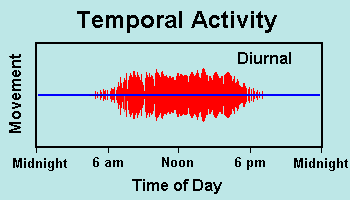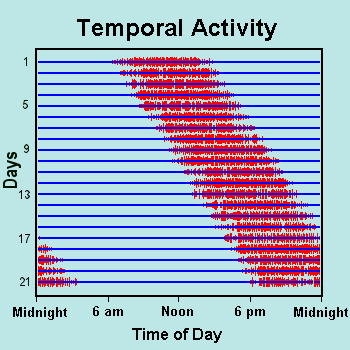Entrainment
Environmental cues such as temperature, light intensity, or location of the sun provide the information animals need to synchronize their behavior with the earth’s daily, monthly, or yearly cycles. The process of establishing and maintaining this synchrony is commonly known as entrainment. In insects, entrainment of periodic behavior usually occurs in one of two ways:
- Exogenous entrainment involves direct response to environmental cues that “trigger” the onset and termination of a particular behavior. In some species of crickets, for example, males begin chirping at nightfall in response to low light intensity and they continue until the light returns at dawn. These crickets will also chirp during a solar eclipse or any time they are covered by a box that keeps out the light. They will not chirp at all if they are exposed to constant illumination. As the name implies, exogenous behavior is regulated by forces “outside” the organism. An experimenter can control when crickets chirp simply by changing the light intensity in their environment.
- Endogenous entrainment involves an internal biological clock that “measures” the passage of time and sends “start” and “stop” signals to the nervous system. These periodic behaviors are often called circadian rhythms. In a cricket species where chirping behavior is controlled endogenously, the males will always start to chirp around dusk, regardless of light intensity. They will not be fooled into chirping during a solar eclipse, or when covered by a box, and they will start chirping around dusk even if the lights are always on. Start and stop signals are generated from “inside” the organism and cannot be arbitrarily changed by an experimentor.
Even with this internal chronometer, an animal’s circadian rhythms must still be synchronized with the environment. As day lengths change throughout the year, insects have to adjust their activity cycles to compensate. In fact, a slight adjustment is made each day in response to a cue (usually light or temperature) from the environment. This signal, which serves as a daily “reset” mechanism for the biological clock, is called a zeitgeber – derived from the German word for “time” (zeit) and the verb “to give” (geben).
In the complete absence of any environmental cues, a biological clock becomes “free-running”. Its endogenous period is usually between 24.5 and 25.0 hours, so the animal’s behavior tends to occur a little later each day as the internal clock gradually drifts out of phase with the environment. Humans experience this same phenomenon in sleep/wake cycles when housed under conditions of constant light or constant dark. We also experience “jet lag” when we travel to a distant time zone. In both humans and insects, it takes several days for the body to adjust to a new photoperiod regime.



